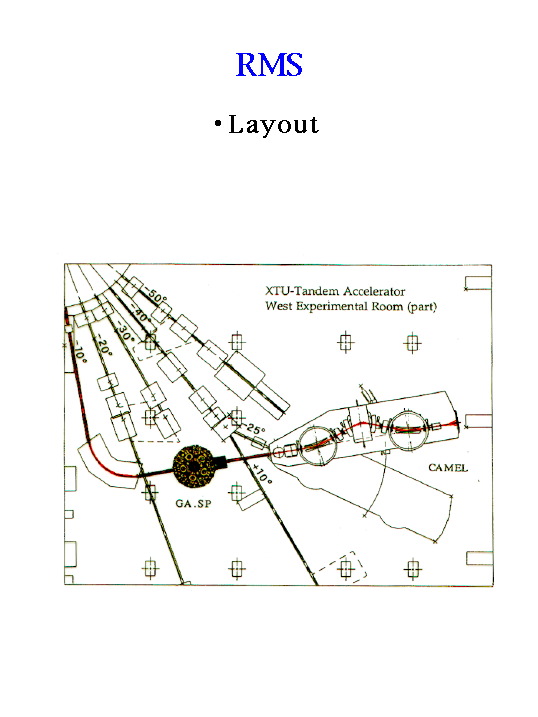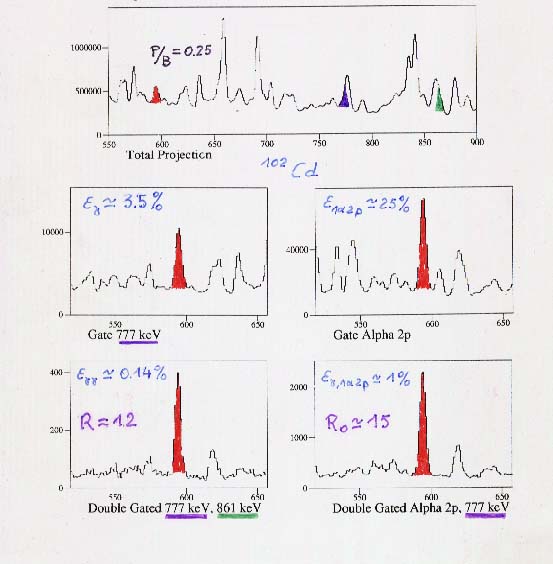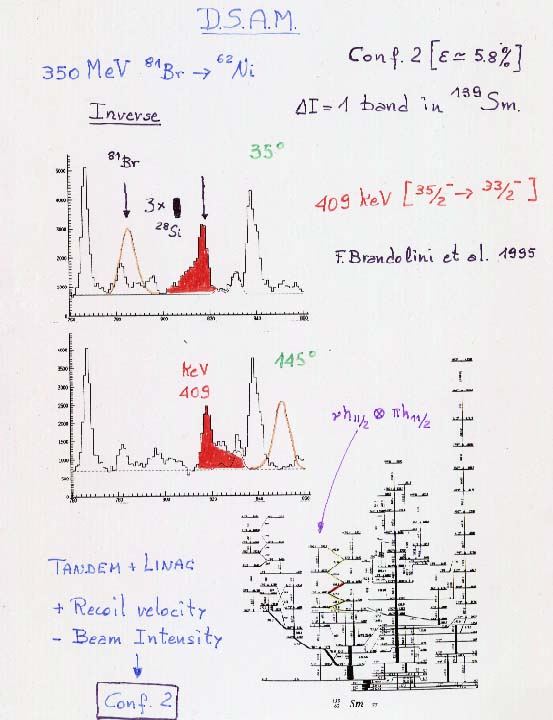The 40 germanium detectors are placed at 27 cm from the target position and cover a total solid angle of 10% of 4
GASP is sited at the Laboratori Nazionali di Legnaro and consists basically of 40 Compton-suppressed hyper-pure high-efficiency n-type germanium detectors (HpGe) which can be complemented by a series of ancillary detection systems. See Fig. 1.
The 40 germanium detectors are placed at 27 cm from the target position and cover a total solid angle of 10% of 4![]() corresponding to a total absolute photopeak efficiency of about 3% at a gamma-ray energy of 1332 keV. For the 60Co source the Compton suppressed spectra have a mean peak to total ratio P/T of about 60-65%. (Ref.1)
corresponding to a total absolute photopeak efficiency of about 3% at a gamma-ray energy of 1332 keV. For the 60Co source the Compton suppressed spectra have a mean peak to total ratio P/T of about 60-65%. (Ref.1)
The average energy resolution of the germanium detectors at 1332 keV is better than 2.3 keV and their average relative efficiency is about 82%.
The main motivation for the development of the multi-detector arrays is clearly related to the need of improving the quality of the data obtained in high spin physics experiments. This explains why they are composed of a large number of Compton Suppressed (CS) germanium detectors each one subtending a relatively small solid angle, in order to reduce the Doppler broadening of the lines emitted by nuclei recoiling at high velocity. At the same time their sensitivity and efficiency are very useful for other experiments where the reaction channels of interest are weakly populated or where precise measurements of physical quantities require high statistics.
The performances of the multi-detector arrays are usually given in terms of the so-called detection limit, which is a function of the photopeak detection efficiency and of the resolving power of the array. The efficiency of the detector is fixed in the design phase, and is limited mainly by budget constrains.
When comparing the performances of such detectors, it is usual to introduce as a figure of merit the so-called observational limit (or sensitivity) which gives the minimum channel intensity alpha that can be detected in the presence of both correlated and uncorrelated background.
See Fig. 5.
The observational limit is reached as a balance of two aspects of every measurement: the request that a multi-dimensional peak should have a minimum number of counts NF defines the statistical limit ![]() stat , whereas the request that the peak-to-background ratio (P/B)F should be larger than a minimum value defines the
stat , whereas the request that the peak-to-background ratio (P/B)F should be larger than a minimum value defines the ![]() back limit.
back limit.
Under very rough assumptions these two quantities can be defined as follows:
 where:
where:
N is the total number of events produced in the reaction,
F is the coincidence order (fold) used in the analysis (assuming unfolding of higher order events),
NF is the area of the multi-dimensional gamma peak under investigation,
k is the fraction of the peak area between the gate limits,
![]() is the efficiency of the ancillary detectors, if present,
is the efficiency of the ancillary detectors, if present,
![]() is the Total photopeak efficiency of the array;
is the Total photopeak efficiency of the array;
 where :
where :
(P/B)F is the peak-to-background ratio of the line in the {F-dimensional} space,
Ro is the resolving power of the added ancillary detector,
R is the resolving power of the array and expresses the reduction of background under a gamma peak which is obtained increasing by one unit the fold of the analysis.
In the case of super deformed (SD) bands R is given by :
 where
where
![]() is the separation interval of the SD band transitions,
is the separation interval of the SD band transitions,
![]() is the experimental resolution (including also Doppler broadening effects),
is the experimental resolution (including also Doppler broadening effects),
![]() is the peak-to-total ratio of the Compton-suppressed germanium detector.
is the peak-to-total ratio of the Compton-suppressed germanium detector.
The resolving power of an array depends essentially on the opening angle of its individual germanium detectors. However its value can be very much improved by coupling the array to ancillary detectors which act as reaction channel selectors.
It is evident from the previous expressions that for a fixed detector design the only way to reduce the detection limit is to add resolving power through ancillary detectors, although this usually involves some reduction of the detection efficiency.
The trade-off between reduced efficiency and increased resolving power will decide the usefulness of the combination for the specific application.
In the case of GASP, in order to improve the resolving power we use routinely three main ancillary detector systems:
- The 4![]() BGO inner ball
BGO inner ball
- The Recoil Mass Spectrometer (RMS) CAMEL.
- The light charged particle detection system ISIS.
The 4![]() inner ball is composed of 80 BGO crystals which cover 80% of the solid angle.
inner ball is composed of 80 BGO crystals which cover 80% of the solid angle.
The geometry of GASP ( Fig. 6) is based on a polyhedron with 122 faces, of which 40 are used for the Germanium detectors (28 in the so-called "hexagonal" positions and 12 in the "pentagonal" ones), 2 are devoted to the beam pipe, and the remaining 80 are used for the detectors of the BGO ball.
The BGO crystals are 65 mm thick: and this gives 95% absorbtion for a 1 MeV gamma-ray, resulting in a total efficiency of 70%. However, for high gamma-multiplicity events, the trigger efficiency of the BGO ball is essentially ![]() = 1.
= 1.
The read-out of the crystal is made with standard PMT's and the electronic treatment of the signals is such that the energy and time information of each individual BGO detector can be recorded.
The BGO ball is used to determine, event by event, the multiplicity and total energy of the gamma cascade. By gating on these quantities one can enhance the reaction channels of interest obtaining a background reduction factor that, although reaction dependent, can be conservatively estimated as R0 = 2-4, Fig.7.
Fig. 8 In order to increase the detection sensitivity, GASP can also be operated in connection with the Recoil Mass Separator (CAMEL) placed downstream in the target hall.Fig. 8.
In order to increase the detection sensitivity, GASP can also be operated in connection with the Recoil Mass Separator (CAMEL) placed downstream in the target hall.Fig. 8.
To preserve high flexibility and autonomy in the use of both instruments, a rough reduction factor of two in the overall ion transmission from the GASP center to the CAMEL focal plane has been accepted.
Evaporation residues emitted at 00 with respect to the beam direction are focused by the RMS into a multi-wire PPAC focal plane detector which extends 12 cm horizontally (X axis) and 8 cm vertically (Y axis). This detector delivers signals corresponding to the X and Y coordinates of the impact point of the ion and the time between the GASP trigger and the the PPAC signal (time of flight).
When using the coupled GASP-RMS system (Ref.2), a mass resolution better than 1/300 and a transmission efficiency which ranges from few percent up to about 20% in the best cases have been observed. Even if the target thickness is important when the mass resolution is an essential condition (in such cases a target thickness smaller than 0.5 mg/cm2 has to be used), a relatively thick target ( about 1 mg/cm2) can be used with only a small deterioration of the RMS performances.
The resolving power RO of the CAMEL spectrometer, i.e. the improvement of the peak-to-background ratio for gamma-ray lines when triggering whith RMS, has been derived comparing spectra obtained with proper gating conditions. The value extracted from total projection spectra ranges from 2 to 6 while the value obtained from gamma-gated spectra ranges from 2 to 4.
Just for comparison, the equivalent improvement obtained when the channel is selected gating on characteristic gamma-rays ranges from 4 to 7 and from 3 to 5, respectively.
As the total transmission efficiency of CAMEL strongly depends on the kinematics of the reaction, it is necessary to carefully check its value for each particular experimental condition. In fact gating on the mass is convenient only if the experimental RMS efficiency is higher than the GASP efficiency for the next higher fold or, in very specific cases, when two nuclei with different mass have lines with the same energy.
 The ISIS array consists of 40 silicon
The ISIS array consists of 40 silicon ![]() E-E telescopes which are used to detect light charged particles (protons and alphas) produced in the reactions.
E-E telescopes which are used to detect light charged particles (protons and alphas) produced in the reactions.
The silicon ball uses the same geometry as the 40 Ge detectors of GASP, being the telescopes positioned on a compact (16 cm diameter) sphere. This geometrical configuration has been chosen in order to minimize gamma-ray absorbtion and scattering which would reduce the detection efficiency and the peak-to-total ratio.
The ![]() E and E detectors have thicknesses of 130 µm and 1 mm respectively. The Si-ball covers a solid angle of about 80% of 4
E and E detectors have thicknesses of 130 µm and 1 mm respectively. The Si-ball covers a solid angle of about 80% of 4![]() and has a telescope detection efficiency of up to 70% and 55% for protons and
and has a telescope detection efficiency of up to 70% and 55% for protons and ![]() respectively.
respectively.
The efficiency reduction with respect to the geometrical coverage is mainly due to total absorbtion of the light charged particles in the thin aluminum foils placed in front of the telescopes to prevent radiation damage from elastically scattered heavy beam ions. As expected, the reduction is higher for alpha particles, since some of them are also stopped in the DE detector.
Clearly the selectivity of GASP when coupled to both ISIS and RMS is increased considerably and this is particularly important when studying weak channels.
As an example, Fig.10 shows the improvement in both ![]() and RO for the 2p1
and RO for the 2p1![]() channel in the 50Cr + 58Ni reaction (Ref.3). The
channel in the 50Cr + 58Ni reaction (Ref.3). The ![]() factor for this channel, which leads to 102Cd, is about 25%. In this case one can compare the effect of gating on charged particles detected with ISIS versus the standard gamma gating. A factor 7 is gained in efficiency and a factor 1.7 in resolving power when using ISIS. It is interesting to note that when setting a further gate on a gamma line the efficiency ratio remains unchanged, while the RO ratio is reduced.
factor for this channel, which leads to 102Cd, is about 25%. In this case one can compare the effect of gating on charged particles detected with ISIS versus the standard gamma gating. A factor 7 is gained in efficiency and a factor 1.7 in resolving power when using ISIS. It is interesting to note that when setting a further gate on a gamma line the efficiency ratio remains unchanged, while the RO ratio is reduced.
Fig. 10
 Spectra showing the (P/B) improvement on the 588 keV line belonging to 102Cd when gating with ISIS in the 2p1alpha channel compared with the correspondening gain in the case of gamma-gating.
Spectra showing the (P/B) improvement on the 588 keV line belonging to 102Cd when gating with ISIS in the 2p1alpha channel compared with the correspondening gain in the case of gamma-gating.
As a further example of the resolving power performances of the GASP array, the results obtained in the spectroscopic investigation of the neutron rich N = 40 spherical shell model nucleus 68Ni are shown in Fig. 12.
Neutron rich nuclei can be presently populated in-beam only by means of fusion-fission and deep-inelastic transfer reactions. With these two reaction mechanisms, at variance with the much more exploited fusion-evaporation one, we have the simultaneous presence in the exit channel of two gamma-ray emitting residues.
As the gamma-radiation from the two residues will be detected in coincidence, the spectra obtained gating with transitions in one particular nucleus will contain also the lines belonging to its reaction partner. Consequently, the analysis of the data is complicated in a significant way although this fact can be exploited, in the so called cross-coincidences method, to identify yet unknown nuclei starting from the coincidences with gamma-rays emitted by known partners. In particular, if isomers are present in one (or even better in both) reaction partner(s) one can reduce the high density of lines which show-up in the inclusive spectra.
Excited states in 68Ni have been populated using a 275 MeV 64Ni pulsed beam and a thin 130Te target . The target was placed on a thick 208Pb backing in order to stop all reaction products in the centre of GASP and observe the decay of their low-lying states in the best conditions.
A description of this experiment can be found in (Ref.4) while in this talk I will consider only the 5- long lived T1/2 = 0.86(5) ms isomer which is an excellent example to show the performances of GASP when both high gamma efficiency and off-beam triggering are used.
How clean are the spectra in this case can be seen in the lower part of Fig.12, where a peak-to-bakground improvement R = 1500 is obtained when gating both on the gamma partners and on the delayed part of the time spectrum.
In Fig. 12 selected experimental results for 68Ni. No background subtraction has been applied to the shown spectra.
There are experimental situations where the most important feature of an array is not the detection limit, but instead its total efficiency. This is the case, for example, when measuring lifetimes of excited states with the Doppler Shift Attenuation Method (DSAM) or with the Recoil Distance Doppler Shift (RDDS) technique, as the precision of the measurement is determined mainly by the collected statistics.
Fig. 13
 In many thick target experiments, where the resolution is not affected by Doppler broadening, any possible gain in efficiency is also highly desirable. For such cases the original GASP project foresaw the so-called configuration 2 (C2).
In many thick target experiments, where the resolution is not affected by Doppler broadening, any possible gain in efficiency is also highly desirable. For such cases the original GASP project foresaw the so-called configuration 2 (C2).
In this configuration the BGO ball is removed and the Ge+AC detectors are moved as close as possible to the target. The collimator function of the BGO ball is obtained with a Pb shield made of two 19 cm dimeter hemispheres having the same geometry of the inner ball. This shield has been made in collaboration with the Institut für Kernphysik, Köln, Germany.
The implementation of C2 reduces the target-germanium distance from 27 cm to about 23 cm for all Ge detectors.
The total photopeak efficiency at 1.33 MeV is thereby almost doubled from 3% in the standard geometry up to 5.8%. As an example of the enhanced performances, the already mentioned experiment on 68Ni, if measured in C2, would have collected the same statistics in a fourth of the time.
Configuration 2 is operational since 1995. Several life-time measurements have been performed using the RDDS method with the Köln plunger device and also with the DSAM technique (see for example Ref.5). The measurement of the E3 transition(Ref.6) strength in 144Nd is another good example of measurements that took advantage of the forward-backward symmetry of GASP.
Fig. 14
 As a last example of results from GASP used in C2 we present some lifetime measurements using the DSAM method.
As a last example of results from GASP used in C2 we present some lifetime measurements using the DSAM method.
In this case, in order to enhance the velocity of the recoil and consequently obtain analyzable line shapes also for very short lived states,a 350 MeV 81Br beam was used.
The beam was accelerated by the Tandem-Linac combination that is operational at LNL since May 1994.
The 139Sm nucleus has been studied through the 62Ni(81Br,p3n) inverse reaction using a 0.5mg/cm2 thick 62Ni gold backed target (Ref.7).
The lifetime measurement could help to confirm this configuration assignment.
In Fig.14 the line shape obtained for the 408.3 keV transition is shown.The line belongs to a dipolar band weakly populated in the reaction.
The dotted line represents the calculated line shape in the case of full shift (FD). The spectra correspond to the total statistics collected in a single ring of 6 detectors at the most forward and backward angles (35o and 135o degrees) in a four day measurement. The recoil velocity induced by the heavy 81Br beam is 3 times higher than that obtained with the lighter 28Si beam which was previously used to study the level scheme of 139Sm.
D.Bazzacco The gamma ray spectrometer GASP.
International Conference on Nuclear Structure at High Angular Momentum
Ottawa, Canada. 1992, May 18-23. Invited Talk.